-
DRV5033デジタル・オムニポーラ・スイッチ・ホール効果センサ
- 1 特長
- 2 アプリケーション
- 3 概要
- 4 改訂履歴
- 5 Pin Configuration and Functions
- 6 Specifications
- 7 Detailed Description
- 8 Application and Implementation
- 9 Power Supply Recommendations
- 10Layout
- 11デバイスおよびドキュメントのサポート
- 12メカニカル、パッケージ、および注文情報
- 重要なお知らせ
パッケージ・オプション
メカニカル・データ(パッケージ|ピン)
サーマルパッド・メカニカル・データ
発注情報
DRV5033デジタル・オムニポーラ・スイッチ・ホール効果センサ
1 特長
- デジタル・オムニポーラ・スイッチ・ホール・センサ
- 優れた温度安定性
- 温度範囲全体にわたってBOP±10%
- 複数の感度オプション(BOP / BRP)
- N極とS極の磁場を検出
- 広い範囲の電圧をサポート
- 2.5V~38V
- 外部レギュレータ不要
- 広い範囲の温度で動作
- TA = –40℃~125℃ (Q、Figure 24を参照)
- オープン・ドレイン出力(30mAシンク)
- 高速な電源オン時間: 35µs
- 小さなパッケージと占有面積
- 表面実装の3ピンSOT-23 (DBZ)
- 2.92mm×2.37mm
- スルーホールの3ピンTO-92 (LPG)
- 4.00mm×3.15mm
- 表面実装の3ピンSOT-23 (DBZ)
-
保護機能
- 逆電圧保護(最大-22V)
- 40Vまでの負荷ダンプをサポート
- 出力短絡保護
- 出力電流制限
2 アプリケーション
- ドッキング検出
- ドアの開閉検出
- 近接感知
- バルブの位置決め
- パルスのカウント
3 概要
DRV5033デバイスはチョッパ安定化されたホール効果センサで、温度範囲全体にわたって優れた感度の安定性を持つ磁気感知ソリューションを提供し、保護機能が内蔵されています。
DRV5033は磁場方向の検出において、両方の極に対して同じように反応します。周囲の磁束密度がBOPスレッショルドを超えると、DRV5033のオープン・ドレイン出力がLOWに変化します。磁場がBRP未満に低下するまで出力はLOWに維持され、その後で出力がハイ・インピーダンスになります。出力電流シンクの容量は30mAです。2.5V~38Vまでの広い範囲の電圧で動作し、-22Vまでは逆極性保護されるため、広範な産業用アプリケーションに適したデバイスです。
逆電圧の状態、負荷ダンプ、および出力短絡や過電流に対して、内部的な保護機能が搭載されています。
製品情報(1)
| 型番 | パッケージ | 本体サイズ(公称) |
|---|---|---|
| DRV5033 | SOT-23 (3) | 2.92mm×1.30mm |
| TO-92 (3) | 4.00mm×3.15mm |
- 提供されているすべてのパッケージについては、巻末の注文情報を参照してください。
出力状態

SOT-23

TO-92

4 改訂履歴
Changes from F Revision (May 2016) to G Revision
- Changed the power-on time for the FA version in the Electrical Characteristics tableGo
- Added the Layout section Go
- Added 「ドキュメントの更新通知を受け取る方法」セクションGo
Changes from E Revision (February 2016) to F Revision
- Revised preliminary limits for the FA versionGo
Changes from D Revision (December 2015) to E Revision
Changes from C Revision (May 2015) to D Revision
- SOT-23パッケージの本体サイズを訂正し、SIPパッケージ名をTO-92に訂正Go
- Added BMAX to Absolute Maximum Ratings Go
- Removed table note from junction temperature Go
- パッケージのテープ&リールに関するMとブランクのオプションを更新Go
- 「コミュニティ・リソース」を追加Go
Changes from B Revision (September 2014) to C Revision
- デバイスのステータスを量産データへ更新Go
Changes from A Revision (August 2014) to B Revision
- Changed the maximum TJ value to 150°C Go
- Added typical rise and fall time and removed maximum value in Switching Characteristics Go
- Updated the Magnetic Characteristics values Go
- Updated all Typical Characteristics graphs Go
- Updated Equation 4 Go
Changes from * Revision (May 2014) to A Revision
5 Pin Configuration and Functions
For additional configuration information, see デバイスのマーキング and メカニカル、パッケージ、および注文情報.
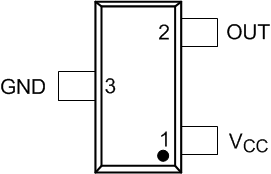

Pin Functions
| PIN | TYPE | DESCRIPTION | ||
|---|---|---|---|---|
| NAME | DBZ | LPG | ||
| GND | 3 | 2 | GND | Ground pin |
| OUT | 2 | 3 | Output | Hall sensor open-drain output. The open drain requires a resistor pullup. |
| VCC | 1 | 1 | PWR | 2.5 to 38 V power supply. Bypass this pin to the GND pin with a 0.01-µF (minimum) ceramic capacitor rated for VCC. |
6 Specifications
6.1 Absolute Maximum Ratings
over operating free-air temperature range (unless otherwise noted) (1)| MIN | MAX | UNIT | ||
|---|---|---|---|---|
| Power supply voltage | VCC | –22(2) | 40 | V |
| Voltage ramp rate (VCC), VCC < 5 V | Unlimited | V/µs | ||
| Voltage ramp rate (VCC), VCC > 5 V | 0 | 2 | ||
| Output pin voltage | –0.5 | 40 | V | |
| Output pin reverse current during reverse supply condition | 0 | 100 | mA | |
| Magnetic flux density, BMAX | Unlimited | |||
| Operating junction temperature, TJ | –40 | 150 | °C | |
| Storage temperature, Tstg | –65 | 150 | °C | |
6.2 ESD Ratings
| VALUE | UNIT | |||
|---|---|---|---|---|
| V(ESD) | Electrostatic discharge | Human body model (HBM), per ANSI/ESDA/JEDEC JS-001, all pins(1) | ±2500 | V |
| Charged device model (CDM), per JEDEC specification JESD22-C101, all pins(2) | ±500 | |||
6.3 Recommended Operating Conditions
over operating free-air temperature range (unless otherwise noted)| MIN | MAX | UNIT | |||
|---|---|---|---|---|---|
| VCC | Power supply voltage | 2.5 | 38 | V | |
| VO | Output pin voltage (OUT) | 0 | 38 | V | |
| ISINK | Output pin current sink (OUT)(1) | 0 | 30 | mA | |
| TA | Operating ambient temperature | –40 | 125 | °C | |
6.4 Thermal Information
| THERMAL METRIC(1) | DRV5033 | UNIT | ||
|---|---|---|---|---|
| DBZ (SOT-23) | LPG (TO-92) | |||
| 3 PINS | 3 PINS | |||
| RθJA | Junction-to-ambient thermal resistance | 333.2 | 180 | °C/W |
| RθJC(top) | Junction-to-case (top) thermal resistance | 99.9 | 98.6 | °C/W |
| RθJB | Junction-to-board thermal resistance | 66.9 | 154.9 | °C/W |
| ψJT | Junction-to-top characterization parameter | 4.9 | 40 | °C/W |
| ψJB | Junction-to-board characterization parameter | 65.2 | 154.9 | °C/W |
6.5 Electrical Characteristics
over operating free-air temperature range (unless otherwise noted)6.6 Switching Characteristics
over operating free-air temperature range (unless otherwise noted)6.7 Magnetic Characteristics
over operating free-air temperature range (unless otherwise noted)| PARAMETER | TEST CONDITIONS | MIN | TYP | MAX | UNIT(1) | |
|---|---|---|---|---|---|---|
| ƒBW | Bandwidth(2) | 20 | 30 | kHz | ||
| DRV5033FA: ±3.5 / ±2 mT | ||||||
| BOP | Operate point; see Figure 12 | TA = –40°C to 125°C | ±1.8 | ±3.5 | ±6.8 | mT |
| BRP | Release point; see Figure 12 | ±0.5 | ±2 | ±4.2 | mT | |
| Bhys | Hysteresis; Bhys = (BOP – BRP)(3) | ±1.5 | mT | |||
| BO | Magnetic offset; BO = (BOP + BRP) / 2 | ±2.8 | mT | |||
| DRV5033AJ: ±6.9 / ±3.5 mT | ||||||
| BOP | Operate point; see Figure 12 | TA = –40°C to 125°C | ±3 | ±6.9 | ±12 | mT |
| BRP | Release point; see Figure 12 | ±1 | ±3.5 | ±5 | mT | |
| Bhys | Hysteresis; Bhys = (BOP – BRP)(3) | 3.4 | mT | |||
| BO | Magnetic offset; BO = (BOP + BRP) / 2 | 5.2 | mT | |||
6.8 Typical Characteristics
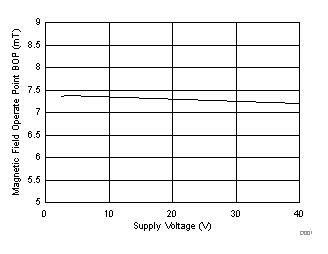
| TA = 25°C | ||

| TA = 25°C |

| TA = 25°C |

| TA = 25°C |
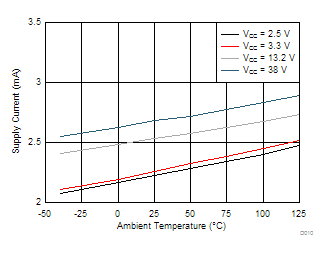

| VCC = 3.3 V | ||
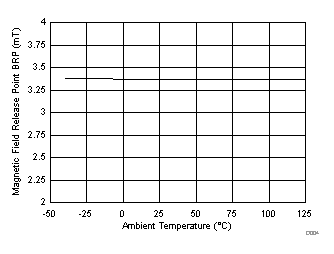
| VCC = 3.3 V |

| VCC = 3.3 V |

| VCC = 3.3 V |
7 Detailed Description
7.1 Overview
The DRV5033 device is a chopper-stabilized hall sensor with a digital omnipolar switch output for magnetic sensing applications. The DRV5033 device can be powered with a supply voltage between 2.5 and 38 V, and will survive –22 V reverse battery conditions continuously. Note that the DRV5033 device will not be operating when about –22 to 2.4 V is applied to VCC (with respect to GND). In addition, the device can withstand voltages up to 40 V for transient durations.
The field polarity is defined as follows: a south pole near the marked side of the package is a positive magnetic field. A north pole near the marked side of the package is a negative magnetic field.
The omnipolar configuration allows the hall sensor to respond to either a south or north pole. A strong magnetic field of either polarity will cause the output to pull low (operate point, BOP), and a weaker magnetic field will cause the output to release (release point, BRP). Hysteresis is included in between the operate and release points, so magnetic field noise will not trip the output accidentally.
An external pullup resistor is required on the OUT pin. The OUT pin can be pulled up to VCC, or to a different voltage supply. This allows for easier interfacing with controller circuits.
7.2 Functional Block Diagram
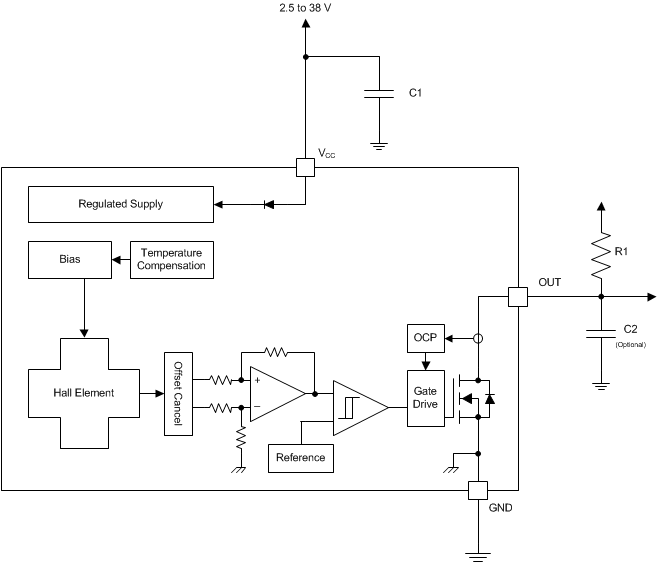
7.3 Feature Description
7.3.1 Field Direction Definition
A positive magnetic field is defined as a south pole near the marked side of the package as shown in Figure 11.
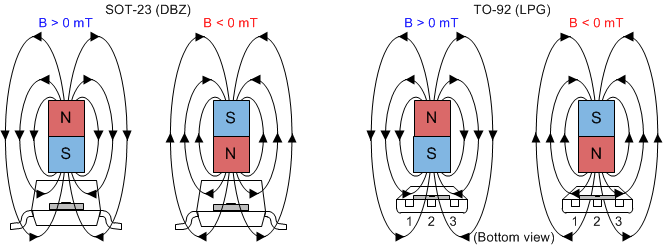
7.3.2 Device Output
If the device is powered on with a magnetic field strength between BRP and BOP, then the device output is indeterminate and can either be Hi-Z or Low. If the field strength is greater than BOP, then the output is pulled low. If the field strength is less than BRP, then the output is released.
 Figure 12. DRV5033—BOP > 0
Figure 12. DRV5033—BOP > 0
7.3.3 Power-On Time
After applying VCC to the DRV5033 device, ton must elapse before the OUT pin is valid. During the power-up sequence, the output is Hi-Z. A pulse as shown in Figure 13 and Figure 14 occurs at the end of ton. This pulse can allow the host processor to determine when the DRV5033 output is valid after startup. In Case 1 (Figure 13) and Case 2 (Figure 14), the output is defined assuming a constant magnetic field B > BOP and B < BRP.
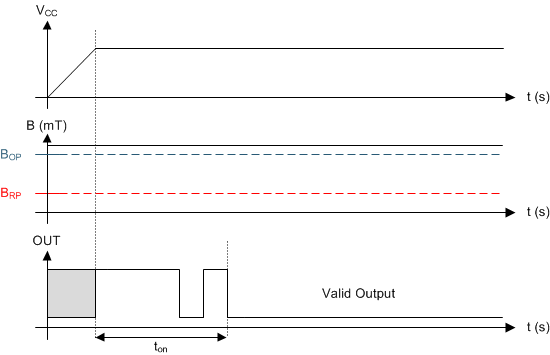 Figure 13. Case 1: Power On When B > BOP
Figure 13. Case 1: Power On When B > BOP
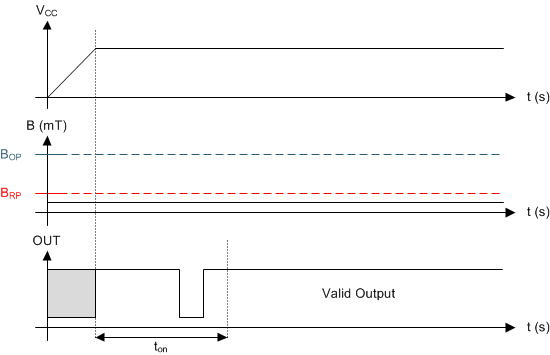 Figure 14. Case 2: Power On When B < BRP
Figure 14. Case 2: Power On When B < BRP
If the device is powered on with the magnetic field strength BRP < B < BOP, then the device output is indeterminate and can either be Hi-Z or pulled low. During the power-up sequence, the output is held Hi-Z until ton has elapsed. At the end of ton, a pulse is given on the OUT pin to indicate that ton has elapsed. After ton, if the magnetic field changes such that BOP < B, the output is released. Case 3 (Figure 15) and Case 4 (Figure 16) show examples of this behavior.
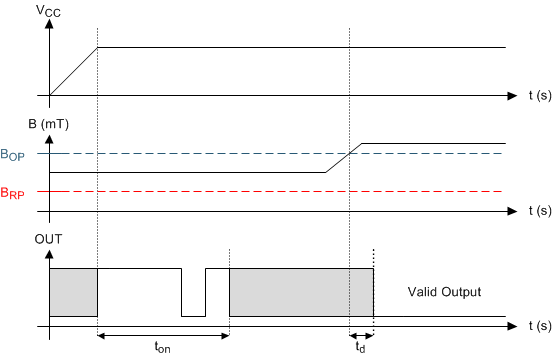 Figure 15. Case 3: Power On When BRP < B < BOP, Followed by B > BOP
Figure 15. Case 3: Power On When BRP < B < BOP, Followed by B > BOP
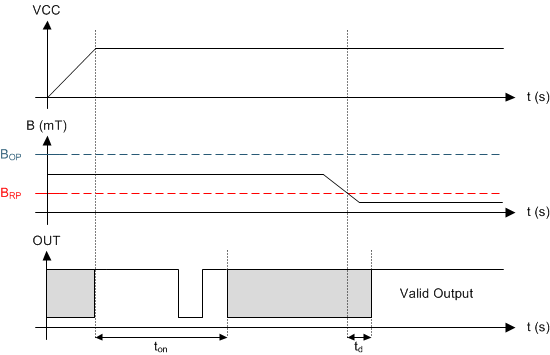 Figure 16. Case 4: Power On When BRP < B < BOP, Followed by B < BRP
Figure 16. Case 4: Power On When BRP < B < BOP, Followed by B < BRP
7.3.4 Output Stage
The DRV5033 output stage uses an open-drain NMOS, and it is rated to sink up to 30 mA of current. For proper operation, calculate the value of the pullup resistor R1 using Equation 1.

The size of R1 is a tradeoff between the OUT rise time and the current when OUT is pulled low. A lower current is generally better, however faster transitions and bandwidth require a smaller resistor for faster switching.
In addition, ensure that the value of R1 > 500 Ω to ensure the output driver can pull the OUT pin close to GND.
NOTE
Vref is not restricted to VCC. The allowable voltage range of this pin is specified in the Absolute Maximum Ratings.
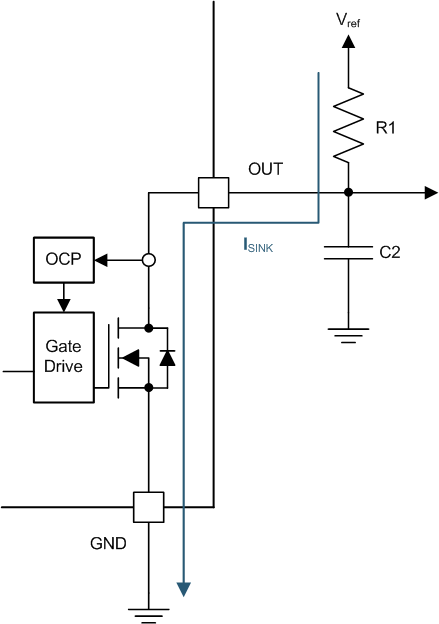 Figure 17.
Figure 17.
Select a value for C2 based on the system bandwidth specifications as shown in Equation 2.

Most applications do no require this C2 filtering capacitor.
7.3.5 Protection Circuits
The DRV5033 device is fully protected against overcurrent and reverse-supply conditions.
7.3.5.1 Overcurrent Protection (OCP)
An analog current-limit circuit limits the current through the FET. The driver current is clamped to IOCP. During this clamping, the rDS(on) of the output FET is increased from the nominal value.
7.3.5.2 Load Dump Protection
The DRV5033 device operates at DC VCC conditions up to 38 V nominally, and can additionally withstand VCC = 40 V. No current-limiting series resistor is required for this protection.
7.3.5.3 Reverse Supply Protection
The DRV5033 device is protected in the event that the VCC pin and the GND pin are reversed (up to –22 V).
NOTE
In a reverse supply condition, the OUT pin reverse-current must not exceed the ratings specified in the Absolute Maximum Ratings.
Table 1.
| FAULT | CONDITION | DEVICE | DESCRIPTION | RECOVERY |
|---|---|---|---|---|
| FET overload (OCP) | ISINK ≥ IOCP | Operating | Output current is clamped to IOCP | IO < IOCP |
| Load dump | 38 V < VCC < 40 V | Operating | Device will operate for a transient duration | VCC ≤ 38 V |
| Reverse supply | –22 V < VCC < 0 V | Disabled | Device will survive this condition | VCC ≥ 2.5 V |
7.4 Device Functional Modes
The DRV5033 device is active only when VCC is between 2.5 and 38 V.
When a reverse supply condition exists, the device is inactive.
